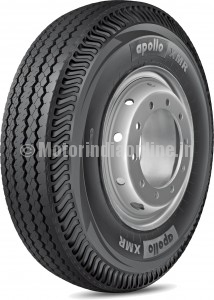Launches new steer axle tyre for extra mileage, durability
India still has more than 77 per cent of cross-ply tyre application in commercial vehicles. The sophistication in vehicles and improvements in road conditions, coupled with load restrictions, is creating better acceptability for new generation products. Higher speeds, many a time with higher loads, are posing new challenges to the conventional cross-ply tyres.

Considering the challenges, Apollo Tyres has introduced a new steer axle tyre ‘XMR’ in cross-ply construction, which is designed for superior mileage and structural durability to deliver best cost of ownership in terms of ‘Total Mileage’; and the total mileage is derived from Initial Tread Mileage (ITM) and Retreaded Tyre Mileage (RTM).
Every step in the creation of the ‘XMR’ is new with highest levels of precision, from the way it was prototyped, manufactured and validated in indoor and outdoor. Tread rib pattern and groove were designed and optimised using ‘thermography’ techniques for the tyre to remain cooler while running and thus extend the casing life for multiple retreads. Design considerations were also given for uniform ‘foot pressure distribution’ and to nullify ‘hot spot’ on the ‘tread rib’ and ‘rib groove’ to benefit uniform wear & part worn appearance which are important parameters to decide on timely removal for retreading.
Commenting on the new XMR tyre, Mr. Satish Sharma, Chief, India Operations, Apollo Tyres Ltd., said: “Apollo holds a leading market position in both drive and steer axle tyres, with many brands leading in different segments. With the introduction of tyres like XT100K and XT 7 Gold+ in the TBB lug design category, it has set a new benchmark in the premium mileage and load & mileage segment. To continue our leadership and create a benchmark in the cross-ply category, especially when radialisation is happening in the heavy commercial vehicle segment, it is important for us to have such differentiating products for the steer axle as well.”

The steer position is the most critical on any HCV, and the tyre used on its steer axle position demands highest design precision and manufacturing controls. The service demand from steer tyre is growing fast due to developments in vehicle technology and infrastructure improvements compounded by radialisation in drive tyres.
UBT concept of manufacturing
A new manufacturing approach, the Uniform Bias Tyre (UBT) technology, has been used for XMR tyres to ensure best performance from this new design. This is achieved by precisely assembling all the components having target dimension and mass on a ‘PLC’-controlled tyre building machine, and subsequently vulcanised for uniform cure index throughout the tyre structure. This process also ensures minimum ‘splice overlap’ during fabric ply preparation and minimises the number of splices per tyre, thereby helping to produce ‘uniform casing’. Over 65 per cent revenue of the Indian tyre industry comes from commercial vehicle tyres where Apollo is the clear market leader. The Indian sub-continent is witnessing a gradual shift in usage trends, with radialisation coming in and customers keen to focus on reaping the benefits of the cost-per-kilometre ratio through better products and lower product and vehicle maintenance costs.
The R&D team at Apollo has used the latest technology & materials, employing advanced design, simulation and testing tools for the XMR tyres, with a four-pronged approach towards technology creation:
* Innovative compounding – High frictional energy tread compounds for higher mileage and long-term bonding technology for enhanced carcass life.
* Design – Functionally optimised tread volume to provide high mileage with better grip, strain-free grooves to avoid groove cracks and uni-stress structure to enhance carcass durability. These design deliverables were extracted through advanced design tools and FEA simulation.
* Testing – Design validation has been done using advanced thermal study tools, destructive testing, field evaluation and retreading.
* Manufacturing – UBT process ensuring accuracy of components and precision in placement.